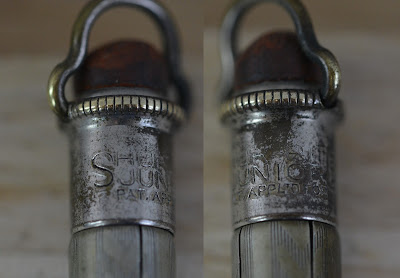This article has been edited and included in The Leadhead's Pencil Blog Volume 4; copies are available print on demand through Amazon here, and I offer an ebook version in pdf format at the Legendary Lead Company here.
If you don't want the book but you enjoy this article, please consider supporting the Blog project here.
The Shur-Rite story is a bit of an anomaly in my book. The design was elegant, cheap and attractive. The publicity was nationwide. The product line numbered in the dozens. And yet, the company emerged in mid-1921 and was apparently gone by the end of 1922.
I still don’t know why it disappeared, but I think now I know where it went.
I last wrote about the Shur-Rite back in July of 2013 (the article is at http://leadheadpencils.blogspot.com/2013/07/these-shur-were-best-they-made.html). To summarize, Julius Swanberg was the inventor of the pencil, and he received two patents for the original and an improved design: number 1,381,517, applied for on November 10, 1919 and awarded June 14, 1921; and number 1,524,062, applied for on June 2, 1921 and awarded January 25, 1925:
Both of these patents were assigned to the Fabart Instrument Company, which according to the Illinois Secretary of State in 1922 was located at 1516 Goster Street, Chicago. The president was E.H. Fabric, and the secretary was R.C. Ritting:
I’ve had a few Shur-Rite pictures around, so I’ll clean them all out here. These first two are on the earlier end of things . . .
The ringtops have a distinctive wire bail - you can spot a Shur-Rite out in an online auction by that top alone:
The caps on these two are marked “Pat. Appl’d For”:
These also are marked patent applied for:
The usual Shur-Rite looks like this inside:
But these lack the pushrod portion:
One is a Shur-Rite Junior, with an exposed eraser:
And the other is marked only patent applied for – leaving me to question whether the pencils predated the company:
These next two are a little later . . . maybe . . .
The ringtop is marked “Pat. Nov. 10, 1919 / Other Pats. Pend’g.”:
You may have noticed a different top on the other example – the cap also has the November 10, 1919 date on it, but this one’s a Shur-Rite Junior:
The November 10, 1919 date was the application date for the first Swanberg patent – not the issue date. I’m not clear whether this was a mistake, or whether it was done on purpose, to imply a patent was issued prematurely. At some point, the error was corrected:
These are all marked with the correct patent date of June 14, 1921:
However, the gold-filled example is missing the Shur-Rite name:
This suggests that the pencils remained in production after the Shur-Rite Pencil Co. either ceased to exist or had sold the rights to the design.
And now, with that photo folder all cleaned out, I’ll explain the rest of what I've learned about the history of the company, and how I think the Shur-Rite might have been related to the Franklin from yesterday's article . . .
Note: the next chapter of this story is at http://leadheadpencils.blogspot.com/2016/01/flash-in-pan.html.

















3 comments:
The address was Foster Street, not Goster, a typo in the original. See https://www.madeinchicagomuseum.com/single-post/swanberg-mfg-co
Trying to get info on a Sure-Rite gold filled fountain pen (gold nib says John Holland CIN.O) and pencil set. Maybe little seen model 214. Both have rings on the end. I think my grandmother used them on a chain at parties to sign dance cards. Any idea of value or where I can go for further information??
I have a gold filled Shur-Rite pencil, and can't seem to find any lead mines that fit. Would you know the size of lead mines I need to be looking for? Thank you so much in advance!
Post a Comment